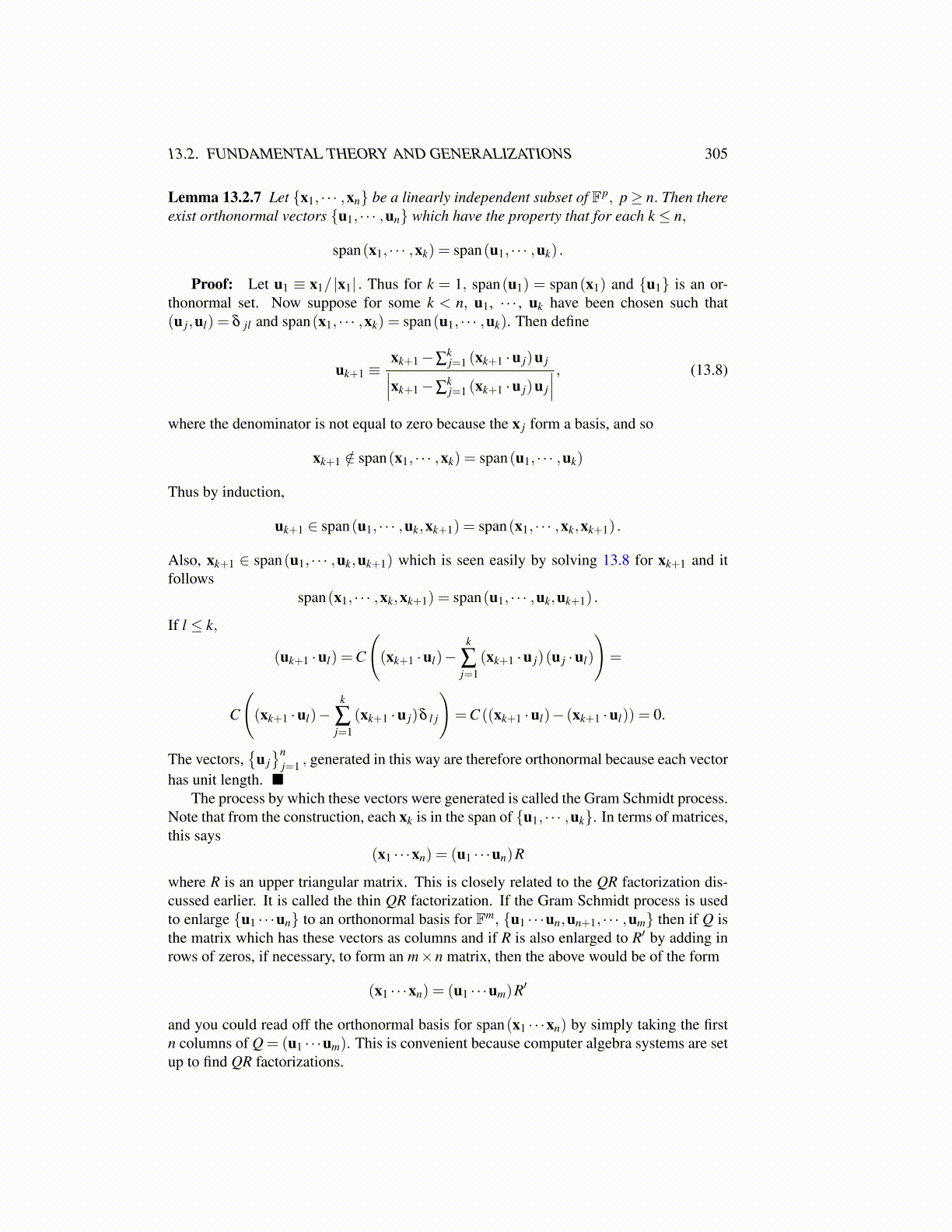
13.2. FUNDAMENTAL THEORY AND GENERALIZATIONS 305
Lemma 13.2.7 Let {x1, · · · ,xn} be a linearly independent subset of Fp, p≥ n. Then thereexist orthonormal vectors {u1, · · · ,un} which have the property that for each k ≤ n,
span(x1, · · · ,xk) = span(u1, · · · ,uk) .
Proof: Let u1 ≡ x1/ |x1| . Thus for k = 1, span(u1) = span(x1) and {u1} is an or-thonormal set. Now suppose for some k < n, u1, · · · , uk have been chosen such that(u j,ul) = δ jl and span(x1, · · · ,xk) = span(u1, · · · ,uk). Then define
uk+1 ≡xk+1−∑
kj=1 (xk+1 ·u j)u j∣∣∣xk+1−∑kj=1 (xk+1 ·u j)u j
∣∣∣ , (13.8)
where the denominator is not equal to zero because the x j form a basis, and so
xk+1 /∈ span(x1, · · · ,xk) = span(u1, · · · ,uk)
Thus by induction,
uk+1 ∈ span(u1, · · · ,uk,xk+1) = span(x1, · · · ,xk,xk+1) .
Also, xk+1 ∈ span(u1, · · · ,uk,uk+1) which is seen easily by solving 13.8 for xk+1 and itfollows
span(x1, · · · ,xk,xk+1) = span(u1, · · · ,uk,uk+1) .
If l ≤ k,
(uk+1 ·ul) =C
((xk+1 ·ul)−
k
∑j=1
(xk+1 ·u j)(u j ·ul)
)=
C
((xk+1 ·ul)−
k
∑j=1
(xk+1 ·u j)δ l j
)=C ((xk+1 ·ul)− (xk+1 ·ul)) = 0.
The vectors,{
u j}n
j=1 , generated in this way are therefore orthonormal because each vectorhas unit length. ■
The process by which these vectors were generated is called the Gram Schmidt process.Note that from the construction, each xk is in the span of {u1, · · · ,uk}. In terms of matrices,this says
(x1 · · ·xn) = (u1 · · ·un)R
where R is an upper triangular matrix. This is closely related to the QR factorization dis-cussed earlier. It is called the thin QR factorization. If the Gram Schmidt process is usedto enlarge {u1 · · ·un} to an orthonormal basis for Fm, {u1 · · ·un,un+1, · · · ,um} then if Q isthe matrix which has these vectors as columns and if R is also enlarged to R′ by adding inrows of zeros, if necessary, to form an m×n matrix, then the above would be of the form
(x1 · · ·xn) = (u1 · · ·um)R′
and you could read off the orthonormal basis for span(x1 · · ·xn) by simply taking the firstn columns of Q = (u1 · · ·um). This is convenient because computer algebra systems are setup to find QR factorizations.